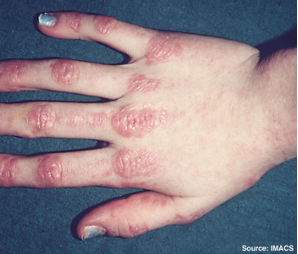Dermatomyositis
Signs and Symptoms
For many decades, dermatomyositis was considered “polymyositis with a rash.” It’s now known that the two diseases have some fundamental differences, but for most doctors, it’s still the skin (“dermato”) manifestations of dermatomyositis that make it a distinct disorder among the muscle diseases.
Skin manifestations
Dermatomyositis is characterized by a number of common skin manifestations that can cause redness and itchiness, and rarely can also cause ulcerations in the skin.
A reddish or purplish rash (heliotrope eruption) may occur on the upper eyelids, nose, cheeks, forehead or scalp (flakiness is not uncommon).
Rashes and discoloration of the skin may occur on the shoulders and upper back, resembling a shawl. It can also resemble a “v-neck” sign when it affects the anterior chest.
Scaling, redness, and/or lesions (Gottron sign/papules) may appear on the knuckles, elbows, knees, and ankles. Redness of the skin caused by an excess of blood in the small blood vessels (periungal erythema) can also occur and may be a subtle manifestation of dermatomyositis.
These and other characteristic skin findings are distinctive to dermatomyositis and can help distinguish the disease from other idiopathic inflammatory myopathies (IIMs).

Image source: Elizabeth M. Dugan et al. https://commons.wikimedia.org/wiki/File:Dermatomyositis.jpg
Muscle weakness
Over time, the inflammatory process in dermatomyositis leads to inflammation of muscle tissue, and is accompanied by weakness. Affected muscles may be stiff, sore, and/or tender and, eventually, show signs of degeneration and atrophy (loss of bulk). The weakness usually becomes noticeable over the course of several weeks, but it can move faster (days) or more slowly (months). The muscles of the shoulders, upper arms, hips, thighs, and neck display the most weakness in dermatomyositis.
Other complications
In some people with dermatomyositis, complications can occur. Affected people may experience:
- Difficulties with swallowing (dysphagia)
- Breathing problems (respiratory insufficiency)
- Inflammation of the heart (myocarditis)
- Hard calcium deposits under the skin (calcinosis)
- Tenderness or bumps due to inflammation of fat lying under the skin (panniculitis)
- Joint pain with or without true arthritis (joint inflammation)
- Inflammation of the blood vessels of other tissues/organs such as the intestinal tract, eyes, and kidneys, leading to damage
- Increased risk of cancer (malignancies)
References
- Dalakas MC. Inflammatory Muscle Diseases. Longo DL, ed. N Engl J Med. 2015;372(18):1734-1747. doi:10.1056/NEJMra1402225
- Baig S, Paik JJ. Inflammatory muscle disease – An update. Best Pract Res Clin Rheumatol. 2020;34(1):101484. doi:10.1016/j.berh.2019.101484
Last update: Feb 2023
Reviewed by Julie Paik, MD, MHS; Johns Hopkins University

